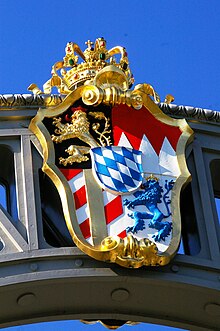Palatinate flag


The Pfalzfahne or Pfälzer Fahne is an unofficial flag of the Pfalz region in the German state Rhineland-Palatinate .
description
An upright striding, red armored and red crowned, golden Palatinate lion on a black background, then the flag cloth divided into black and gold (or yellow), derived from the main colors of the coat of arms.
History of the region and its coat of arms
The region of the state of Rhineland-Palatinate, known today as the Pfalz, belonged to the Kingdom of Bavaria until 1918, as the “Kreis Pfalz” , and then, until 1946, to the Free State of Bavaria .
The upright striding, red armored and later also red crowned, golden Palatinate lion on a black background has been proven as the coat of arms of the Palatinate County near the Rhine since the 13th century . This symbol of the Palatinate County was included in the Wittelsbach house coat of arms early on , alongside the white and blue alarm clocks of the County of Bogen . The University of Heidelberg was founded in 1386 . On her seal from the founding period, St. Peter sits on a throne, holding a powerful key. Elector Ruprecht I kneels to the right and holds the Palatinate coat of arms with the lion in homage to him. To the left of the Prince of the Apostles, the co-regent and electoral successor Ruprecht II kneels , who also presents the Wittelsbach diamond coat of arms to Peter.
In 1837, King Ludwig I of Bavaria divided his kingdom into 8 circles, after he had already enacted a new national coat of arms in 1835, in which the Palatinate was symbolized by the historical black coat of arms with an upright, red armored and red crowned golden lion. This coat of arms became a symbol of the Palatinate, and in 1948 it was also incorporated into the new coat of arms of Rhineland-Palatinate . It also appears in the new Bavarian state coat of arms , but with an uncrowned lion.
History of the flag
When the Kingdom of Bavaria was reorganized in 1837, no coat of arms was allocated to the individual districts, but the Palatinate was represented in the state coat of arms with its historical black and gold coat of arms. During festivities, flags were used here in the national colors of white and blue or in the municipality colors, but a flag of the region was missing in large parts of the population.
In Billigheim resident country doctor Dr. Friedrich Heitz († 1948) was committed to local history and developed the idea of creating a flag of the Palatinate. He presented them at the 1909 exhibition of the “Association of Palatinate Artists and Art Friends” in Neustadt an der Weinstrasse . The prototype was designed and painted by the artist August Croissant , but was later changed slightly. The Mayor of Deidesheim , Ludwig Bassermann-Jordan , also a local local historian, expressed his approval at the exhibition, and the Mayor of Neustadt, Theodor Wand, ordered a flag to be used in the town hall. In the publications of the Palatinate Forest Association , the Dr. Heitz was an active member, the new Palatinate flag was strongly promoted. It spread in the region and the Palatinate Forest Association had it hung on the local castles.
Since the Palatinate was not officially given a coat of arms or colors and there was fear of separatist tendencies, the Bavarian State Ministry of the Royal House and Foreign Affairs banned the Palatinate flag on February 13, 1915. This ban remained in place until the Palatinate left the Bavarian State Association Force.
Flags that still existed kept appearing on private houses. At the end of the 20th century, the flag was re-manufactured and promoted. It has now established itself and you can often see it again in the streets of the region.
Since 2010, two commemorative masses for the Palatinate-Bavarian ruling house Wittelsbach have been held annually in the Neustadt collegiate church . To this end, appears regularly Alois Konstantin of Löwenstein-Wertheim-Rosenberg , the direct descendant of the Elector Palatine Friedrich I. On this occasion the honor of the head of the former ruling house is always decorated with the Palatinate flag.
literature
- Ottfried Neubecker : Palatinate flags , Neustadt an der Haardt, 1932
- Celia Applegate: A Nation of Provincials: The German Idea of Heimat, University of California Press , 1990, p. 102 u. 103, ISBN 0520063945 ; (Digital scan)
Web links
- Website 100 years of the Palatinate flag
- Entry in the flag dictionary
- Website of the historical association Kaiserslautern, about the Palatinate flag
Individual evidence
- ^ Werner Moritz: From 1386 - The logo of the Heidelberg University. ( Memento of the original from February 11, 2009 in the Internet Archive ) Info: The archive link was automatically inserted and not yet checked. Please check the original and archive link according to the instructions and then remove this notice. at uni-heidelberg.de
- ^ Friedrich Heitz: The new Palatinate flag , in: Das Bayerland , 1911, pp. 305-308 u. 321-323; (Digital view 1) , (digital view 2)
- ↑ Website with scan of the prohibition order
- ^ Website on the Wittelsbach masses in the Neustadt collegiate church
